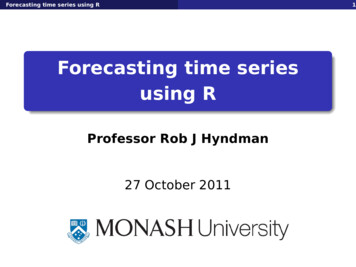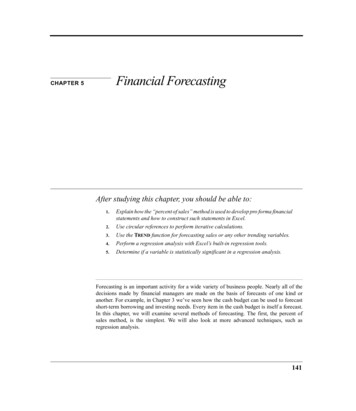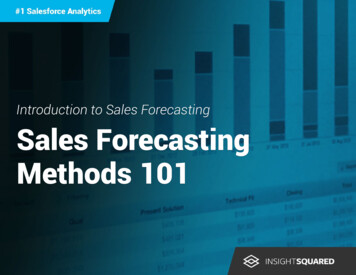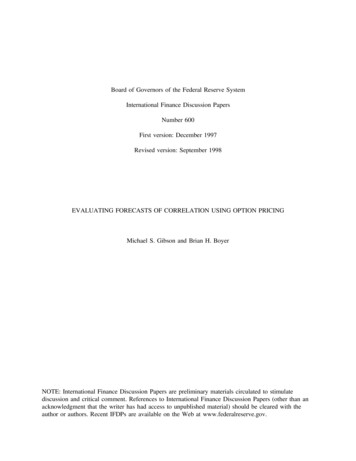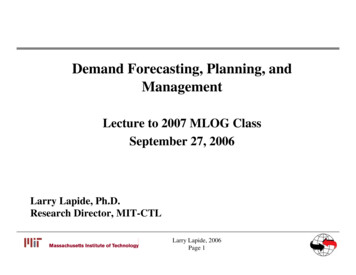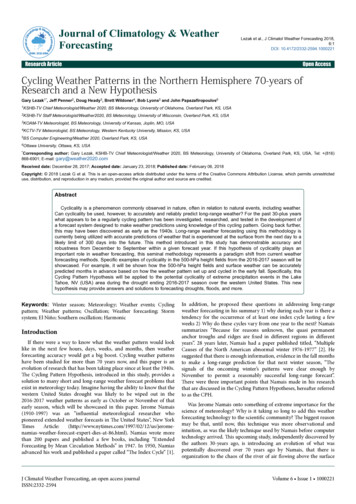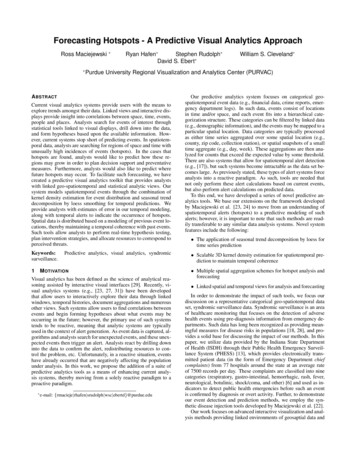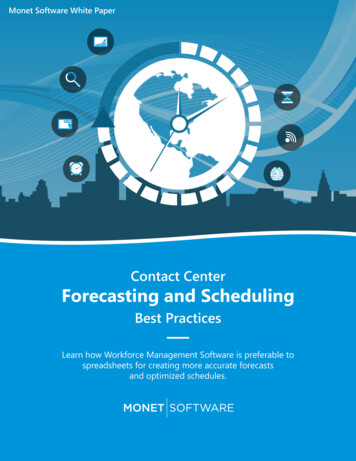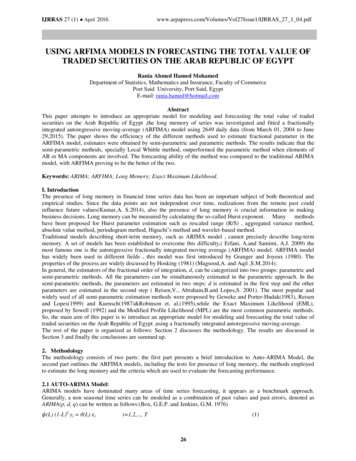
Transcription
IJRRAS 27 (1) April 2016www.arpapress.com/Volumes/Vol27Issue1/IJRRAS 27 1 04.pdfUSING ARFIMA MODELS IN FORECASTING THE TOTAL VALUE OFTRADED SECURITIES ON THE ARAB REPUBLIC OF EGYPTRania Ahmed Hamed MohamedDepartment of Statistics, Mathematics and Insurance, Faculty of CommercePort Said University, Port Said, EgyptE-mail: rania.hamed@hotmail.comAbstractThis paper attempts to introduce an appropriate model for modeling and forecasting the total value of tradedsecurities on the Arab Republic of Egypt ,the long memory of series was investigated and fitted a fractionallyintegrated autoregressive moving-average (ARFIMA) model using 2649 daily data (from March 01, 2004 to June29,2015). The paper shows the efficiency of the different methods used to estimate fractional parameter in theARFIMA model, estimates were obtained by semi-parametric and parametric methods. The results indicate that thesemi-parametric methods, specially Local Whittle method, outperformed the parametric method when elements ofAR or MA components are involved. The forecasting ability of the method was compared to the traditional ARIMAmodel, with ARFIMA proving to be the better of the two.Keywords: ARIMA; ARFIMA; Long Memory; Exact Maximum Likelihood.I. IntroductionThe presence of long memory in financial time series data has been an important subject of both theoretical andempirical studies. Since the data points are not independent over time, realizations from the remote past couldinfluence future values(Kumar,A. S.2014), also the presence of long memory is crucial information in makingbusiness decisions. Long memory can be measured by calculating the so-called Hurst exponent. Many methodshave been proposed for Hurst parameter estimation such as rescaled range (R/S) , aggregated variance method,absolute value method, periodogram method, Higuchi’s method and wavelet-based method.Traditional models describing short-term memory, such as ARIMA model , cannot precisely describe long-termmemory. A set of models has been established to overcome this difficulty,( Erfani, A.and Samimi, A.J. 2009) themost famous one is the autoregressive fractionally integrated moving average (ARFIMA) model. ARFIMA modelhas widely been used in different fields , this model was first introduced by Granger and Joyeux (1980). Theproperties of the process are widely discussed by Hosking (1981) (Magsood,A. and Aqil ,S.M.2014).In general, the estimators of the fractional order of integration, d, can be categorized into two groups: parametric andsemi-parametric methods. All the parameters can be simultaneously estimated in the parametric approach. In thesemi-parametric methods, the parameters are estimated in two steps: d is estimated in the first step and the otherparameters are estimated in the second step ( Reisen,V., Abraham,B.and Lopes,S. 2001). The most popular andwidely used of all semi-parametric estimation methods were proposed by Geweke and Porter-Hudak(1983), Reisenand Lopes(1999) and Kuensch(1987)&Robinson et. al.(1995),while the Exact Maximum Likelihood (EML),proposed by Sowell (1992) and the Modified Profile Likelihood (MPL) are the most common parametric methods.So, the main aim of this paper is to introduce an appropriate model for modeling and forecasting the total value oftraded securities on the Arab Republic of Egypt ,using a fractionally integrated autoregressive moving-average.The rest of the paper is organized as follows: Section 2 discusses the methodology. The results are discussed inSection 3 and finally the conclusions are summed up.2. MethodologyThe methodology consists of two parts: the first part presents a brief introduction to Auto-ARIMA Model, thesecond part outlines the ARFIMA models, including the tests for presence of long memory, the methods employedto estimate the long memory and the criteria which are used to evaluate the forecasting performance.2.1 AUTO-ARIMA Model:ARIMA models have dominated many areas of time series forecasting, it appears as a benchmark approach.Generally, a non seasonal time series can be modeled as a combination of past values and past errors, denoted asARIMA(p, d, q) can be written as follows:(Box, G.E.P. and Jenkins, G.M. 1976)(L) (1-L)d yt θ(L)tt 1,2,., T(1)26
IJRRAS 27 (1) April 2016Mohamed Forecasting the Total Value of Traded SecuritiesIn practice, several time series contain a seasonal periodic component, which repeats every observation. To dealwith seasonality, the ARIMA model is extended to a general multiplicative seasonal ARIMA (SARIMA) model,which is defined as follows:( Shabri, A.,2001; Suhartono,2011)(L) Ф (L S) (1- L )d (1- L S)D yt θ(L)Θ(L S)(2)tWhere:(L) (L) ( ) ( ) Where yt is the data set after appropriate transformation of time t while (1- L)d and (1- L S)D are the non-seasonal andseasonal differencing operators respectively. ,θ Autoregressive & Moving average coefficients respectively. Ф,ΘSeasonal Autoregressive &Seasonal Moving average coefficients respectively. p, q are orders of non-seasonalautoregressive and moving average parameters respectively. P, Q are orders of the seasonal autoregressive andmoving average parameters respectively. Back shift operator and t is random error ( t. The model (2) is(called a SARIMA model of order (.Hyndman and Khandakar (2008) also propose an automatic forecasting approach (AUTO-ARIMA) in which theappropriate model order (the values p, q, P, Q, D, d) are selected based on Akaike's (1974) information criterion(AIC) or Schwarz's (1978) Bayesian criterion (SBC) as indicated below(Hyndman,R.J.and Khandakar ,Y.2008):(((Where(3)((4)is the maximized likelihood of the model fitted; k the number of Parameters to be estimated2.2 ARFIMA modelThe autoregressive fractionally integrated moving average (ARFIMA) model was first introduced by Granger andJoyeux (1980) and Hosking (1981)( Magsood,A. and Aqil ,S.M.2014;Lildholdt,P.2000).It is a generalization of theARIMA model (eq.1) to non- integer values of d.(1- L)d is fractionally difference operator defined by the following binomial expansion:( Li,W.K.1986, Erfani, A.and Samimi, A.J. 2009;Doornik, J.A. and Ooms, M.2004; Joe,B.and Sisir,R.2014)(( )( (5)(((with(((( and(((((6)(7)j 0,1,2,.(8)An ARFIMA (p,d,q) process may be differenced a finite integral number until d lies in the interval [-0.5,0.5] andwill then be stationary and invertible (Sun ,R., Chen, Y. and Li, Q.2007). When d 0.5 , the ARFIMA process isstationary but not invertible. If 0.5 d 0, the ARFIMA process has an intermediate memory or over differenced.In that case the inverse autocorrelations decay hyperbolically. When d 0, the ARFIMA process can be white noiseand When 0 d 0.5 , the ARFIMA (p,d,q) process is a stationary process with long memory and the autocovariance function exhibits hyperbolic decay (Doornik, J.A. and Ooms, M.2004;Sun ,R., Chen, Y. and Li, Q.2007).The following part introduces the theoretical methods for testing the long-memory process followed by the methodsused to estimate ARFIMA models.27
IJRRAS 27 (1) April 2016Mohamed Forecasting the Total Value of Traded Securities2.2.1 Testing of Long MemoryIn dealing with the long memory processes, the first and foremost step is to have an idea for the possible presence oflong memory behavior in time series. Long memory can be measured by calculating the so-called Hurst exponent.A stationary stochastic process { } is called a long memory process if there exists a real number H and a finiteconstant C such that the autocorrelation function York ( has the following rate of decay:(Alptekin,N.2007)((9)The parameter H, Hurst Exponent, display the long memory property of the time series.The Hurst exponent takes values from 0 to 1 (0 H 1). If 0.5 H 1, the series indicates persistent behavior orlong memory. If there is an increase from time steptothere will probably be an increase from to. On the other hand, the same is true for decreases. If H 0.5, theseries is a random walk. If 0 H 0.5, the series is called anti-persistent. In this case, an increase will tend to befollowed by a decrease or a decrease will be followed by an increase. This behavior is sometimes called meanreversion.Many methods have been proposed for Hurst parameter estimation such as rescaled range (R/S), aggregatedvariance method, absolute value method, periodogram method, Higuchi’s method and wavelet-based method.2.2.1.1 Rescaled range statistic (R/S)The first test for long memory was used by the hydrologist Hurst (1951) for the design of an optimal reservoir forthe Nile River, of where flow regimes were persistent. Hurst gave the following formula:((10)is the rescaled range statistic measured over a time index n, c is a constant and H the Hurst exponent. The aimof the R/S statistic is to estimate the Hurst exponent which can characterize a series. Estimation of Hurst exponentcan be done by transforming to:((((11)Rescaled range statistic (R/S) is defined as the range of partial sums of deviation of a time series from its mean,rescaled by its standard deviation. Consider the sample {from a stationary long memory process {let the partial sums of is ; k 1,2,.,n (Let ̅, and̅ be the sample mean and sample variance respectively. TheRescaled range Statistic(R/S) is defined as:( Magsood,A. and Aqil ,S.M.2014) :[( (̅ )( (̅ )](12)Wheren: number of observations: the standard derivationIn addition, the Hurst coefficient H can be used to estimate the fractional differencing parameter d by the equation:(13)This method is considered as semi parametric of estimating ARFIMA models.2.2.1.2 Aggregated Variance MethodThis method divides the original time series X {Xi, i 1} into blocks of size m and average within each block, thatis, consider the aggregated series:(( ((qThen, divide the data,Li, Q.2007).̂( (14), into N/m blocks of size m, and calculate its sample variance(Sun ,R., Chen, Y. and(((( (()(15)(, as m Where is the scale parameter andthe sample variance ̂ (should be asymptoticallyproportional tofor large N/m and m, the resulting points should form a straight line with slope.28
IJRRAS 27 (1) April 2016Mohamed Forecasting the Total Value of Traded Securities2.2.1.3 Absolute Value MethodThe data is divided in the same way as the aggregated variance method to form aggregated series, the sum of theabsolute values of the aggregated series is computed as (Sun ,R., Chen, Y. and Li, Q.2007): (( (16)The logarithm of this statistic is plotted versus the logarithm of m. For long-range dependent time series withparameter H, the result should be a line with slope H 1.2.2.1.4 Periodogram method.This method plots the logarithm of the spectral density of a time series versus the logarithm of the frequencies. Theslope provides an estimate of H, the periodogram is given by(Karagiannis,T. and Faloutsos 2002):(( (17)where is the frequency, ( is an estimate of the spectral density of the series. A log-log plot of (a slope of 1 2H close to the origin. N is the length of the time series, and X is the actual time series.should have2.2.1.5 Wavelet MethodThe Hurst exponent is calculated from the wavelet spectral density by fitting a linear regression line through a set ofpoints, where is the octave and is the logarithm of the normalized power. The slope of this regression line isproportional to the estimate for the Hurst exponent (Sun ,R., Chen, Y. and Li, Q.2007;Kirichenko,L.,Radivilova,T.and Deineko Z.2011):( ( ( ) ((18)From this formula, it can be concluded that if there is the long-range dependence of the time series then the Hurstexponent can be obtained by estimating the slope of the graph of the functionfrom .2.2.1.6 Higuchi’s MethodHiguchi’s method (Higuchi, 1988) is a time domain method useful for non-stationary series, but performs the multiscale analysis with the creation of subseries( Esposti, F. and Signorini, M. G.2006).2.2.2 Estimation ARFIMA modelsThere are two types of estimation methods : semi-parametric and parametric methods. The methods which areimplemented in this paper are described below.2.2.2.1Semi-parametric Estimation MethodsThe most popular and widely used of all semi-parametric estimation methods was proposed by Geweke and PorterHudak(1983)( Joe,B.and Sisir,R.2014 ),this method is based on an approximated regression equation obtained fromthe logarithm of the spectral density function. The GPH estimation procedure is a two-step procedure which beginswith the estimation of d (Paul ,R. K.2014)[73]and is based on the following log-periodogram regression(Bhardwaj,G. and Swanson, N.R.2006 ).([()](19)whereThe estimate of d, say ̂ GPH; isperiodogram defined as:̂represents the Fourier frequencies, and (denotes the sample( (20)The second step of the GPH estimation procedure involves fitting an ARMA model to data according to box andjenkins method , given the estimate of d. the GPH estimate is denoted as ̂. Reisen and Lopes (1999) modifiedthe GPH procedure by replacing the periodogram by a "smoothed" estimate of the spectral density. Reisen andLopes (1999) proposed to use a Blackman- Tukey type estimate of the spectral density(Joe,B.and Sisir,R.2014)( ( ) ̂(((21)29
IJRRAS 27 (1) April 2016Mohamed Forecasting the Total Value of Traded SecuritiesHenceforth, the smoothed periodogram estimate of d is denote as ̂ Sperio. Both ̂ GPH and ̂ Sperio although simpler toimplement are inefficient in the non-stationary region i.e. 1 2.Another semi-parametric estimator, the local Whittle estimator, is also often used to estimate d. This estimator wasproposed by Kuensch (1987) and modified by Robinson (1995). The local Whittle estimator of d; say ̂ is obtainedby maximizing the local Whittle log likelihood at Fourier frequencies close to zero, given by( Bhardwaj ,G. andSwanson, N.R.2006):(( (((22)2.2.2.2 parametric Estimation MethodsThe Parametric methods estimate all parameters of the ARFIMA process in one step. Exact Maximum Likelihood(EML), proposed by Sowell(1992). The EML method is chosen in this paper for estimating the parameters ofARFIMA model.Let y be the sample time series. The log-likelihood of the estimation is simply, based on the normality assumptionand with a procedure to compute the autocovariances in the T T covariance matrix of a T 1 vector ofobservations y, the log-likelihood for the ARFIMA(p, d, q) model (4) with k regressors is(Lildholdt,P.2000;Doornik, J.A. and Ooms, M.2004) :́ whereWhenand(23)are concentrated out, the resulting normal profile likelihood function becomes:( ̂́̂(24)Where ̂ y- ̂and̂ (́) ́(25)2.2.3 Evaluation of the Forecasting PerformanceThis subsection presents the tools for comparing the forecasting performances of different models. In this paper, theforecasts from the estimated models are compared using the root mean squared error (RMSE), the mean absoluteerror (MAE) and the mean absolute percentage error (MAPE) are given below ( Joshi, P.,2014; Ramzan,S.,S.Ramzan,and F.M. Zahid, 2012). ̂( (26)̂ ̂(27) (28)Where ̂are the estimated and actual values respectively , is the number of data. The model with betterforecasting power has lower values of all the above measures compared to other models.3. The resultsThis section reports the empirical results obtained. started with ARIMA model, then progress to ARFIMA models,the ARFIMA model was fitted using parametric and semi-parametric methods, the tests for long memory wereperformed and evaluate the forecasting performances of estimated models . Before reporting the results, let us firstintroduce the data analyzed in our study.3.1 Data DescriptionThe data used in this paper the daily total value of traded securities on the Arab Republic of Egypt cover the periodsfrom March 01, 2004 to June 29,2015, with a total of 2649 observations. The data from March 01,2004 to February26, 2015 with 2568 observations are used as training sample for model estimation ,and the remaining 81observations from March 01, 2015 to June 29, 2015 are used as post sample for forecast evaluation. The data setsare obtained from the Egyptian Cabinet Information and Decision Support Center. Descriptive statistics for theseries are shown in Table (1):30
IJRRAS 27 (1) April 2016Mohamed Forecasting the Total Value of Traded SecuritiesTable(1) Descriptive StatisticsNo. ngARCHLM-testVarianceratio 513As Table (1) shows, the series of the total value of traded securities on the Arab Republic of Egypt has the mean of770 and the standard deviation of 925.52 in the sample period, suggesting that it has been highly volatile. Inaddition, Jarque-Bera and kurtosis statistics show that the series is not normally distributed . Based on the LjungBox statistics (10 lags), the null hypothesis of “No serial correlation” is rejected. ARCH LM test confirms there isno ARCH effect. The variance ratio test investigates that the generating process of the data is not random walk.Thus, this series can be modeled and forecasted by different models. Finally, there are a few outliers in the returnseries, which are taken away from all series to avoid their effects on estimation.3.2 ARIMA models.In this part, a popular method of time series forecasting were employed; Autoregressive Integrated Moving Average(ARIMA) .The data are used from March 01,2004 to February 26, 2015. Auto.arima function conducts a search overpossible model within the order constraints provided and returned the best ARIMA model according to either AIC orBIC value.(Pravilovic,S.and Appice, A.2013). Based on the results of the Auto-ARIMA, conclude that ARIMA(5,1,4) can be appropriate to model the series. Hence the proposed ARIMA model is given as1:3.3ARFIMA modelIn this part ,the long memory of total value of traded securities on the Arab Republic of Egypt were investigated andfitted a suitable fractionally difference ARMA model, as the first step, the long memory for the series was testedusing R/S method, Aggregated Variance method, Absolute Value Method , Higuchi’s Method and WaveletMethod. The results are given in Table (2).R/SMethodH 0.9747228AggregatedVariance MethodH 0.97378048Table(2) H estimatesMomentHiguchiMethodMethodH 0.992425898 H 0.9670275Peng MethodH 0.9673876WaveletMethodH 1.00The estimated of Hurst Exponent 0.5 H 1, so this result provides more evidence for the existence of the longmemory property.The models that consider the long memory property are very sensitive to the estimation of long-memory parameters,for this reason in this paper, the GPH ( ̂ GPH), the smoothed GPH( ̂ Sperio), the Local Whittle ( ̂ W) and the R/S( ̂ R/S)were used as the semi-parametric methods, while used Exact Maximum Likelihood estimation as the parametricmethods.The difference parameter d, is compared as well as the parameters of the ARFIMA model, different combinations oforder of autoregressive polynomial and moving average polynomial are taken and selected the appropriate modelfrom each method as having the minimum values of AIC and BIC. Furthermore, a number of criteria wereemployed such as Root Mean Squared Error (RMSE), Mean Absolute Error (MAE) and Mean Absolute PercentageError (MAPE) in the analysis to judge the performance of estimated models. Diagnostic tests such as the Ljung-Box1The R software package has been used for data analysis.31
IJRRAS 27 (1) April 2016Mohamed Forecasting the Total Value of Traded SecuritiesQ test and the ARCH-LM test are performed on the series. The results for all these estimation methods are given inTable (3).Table 3: Results of Estimated parameters𝑑̂ GPH 0.876(1,d,2)̂𝑑 Sperio 0.786(5,d,1)𝑑̂ W 0.413(1,d,2)𝑑̂ R/S 0.474(1,d,2)EMLd * 0.479(1,d,0)EMLd * 0.492(2,d,0)ARIMA(5, 1, 4)AICBICRMSEMAEMAPEARCH .41288.6702[0.7308]5.3952s[0.8633]* The estimated d is statistically significant.* The last two columns of Table 1 report test residual diagnostics for the estimated models; Portmanteau test for residualautocorrelation is the Ljung & Box statistic with the used lag length in parentheses, LM test for ARCH effects. P-values ofthe statistics are reported between square brackets.It is seen from table (3) the Portmanteau test result showed that there is no serial correlation in all significance levelsexcept ARFIMA (1,0.479,0) and ARFIMA (2,0.492,0). Furthermore, ARCH tests are applied to the residual series,to ensure that the null hypothesis of no ARCH effect is not rejected in all models.In general, the models selected according to each method are ARFIMA (1,0.474,2), (1,0.876,2),(5,0.786,1),(5,0.722,1) ,(1,0.413,2), (1,0.479,0) and (2,0.492,0).Table 1 shows that the ARFIMA (1,0.479,0) and ARFIMA (2,0.492,0) does not perform well. The ARFIMA(1,0.876,2) model presents the lowest AIC and BIC, the ARFIMA (1,0.786,2) model presents the lowest RMSE andMAE value. While ARFIMA (1,0.413,2) model presents the lowest MAPE value. It can be concluded that the mostaccurate models compared to other models are: ARFIMA (1,0.876,2) ,ARFIMA (1,0.786,2) and ARFIMA(1,0.413,2). Moreover, no ARCH-effects, and no autocorrelation in the models.After appropriate ARFIMA models have been gotten, the next is to see its ability for forecasting the data. Theevaluation of forecasting accuracy should ideally be conducted on data outside the sample period used to formulatethe model. In order to make comparisons between the appropriate ARFIMA models, data from March 01, 2015 toJune 29, 2015 daily values were used. Table (4) represents the results of the models based on the three differentaccuracy performance measures: RMSE, MAE, and MAPE. For each error calculation lower values are preferred.32
IJRRAS 27 (1) April 2016Mohamed Forecasting the Total Value of Traded SecuritiesTable 4: Validation of Estimated Modelsd 0.7219𝑑̂ GPH 0.876𝑑̂ Sperio 0.786𝑑̂ LWE 0.413(5,d,1)(1,d,2)(5,d,1)(1,d,2)Models𝑑̂ R/S .32771.79341.15499.98ARIMA (5, 1, 4)As shown in Table (4), the performance of the types of models in out-of-sample forecasting confirms the superiorityof the model ARFIMA(1,0.413,2). The strength of the ARIMA model in forecasting real imports is considerable,tables 3 and 4 show that the ARIMA does not perform well. That the most accurate model is conclude to forecast thetotal value of traded securities on the Arab Republic of Egypt is ARFIMA(1,0.413,2) model which given as:CONCLUSIONThis paper aimed to introduce an appropriate model for modeling and forecasting the total value of traded securitieson the Arab Republic of Egypt, for the aimed, the modified rescaled range , aggregated variance method, absolutevalue method, periodogram method, Higuchi’s method and wavelet-based method are employed to identify the longmemory behavior of series. The presence of long memory in series indicates that it would be better to develop andemploy ARFIMA models. Both parametric and semiparametric methods were considered. The models selectedaccording to each method are ARFIMA (1,0.474,2), (1,0.876,2), (5,0.786,1),(5,0.722,1) ,(1,0.413,2), (1,0.479,0) and(2,0.492,0). Finally, models are found to be more adequate for describing, explaining and forecasting the series areARFIMA (1,0.876,2), ARFIMA (1,0.786,2) and ARFIMA (1,0.413,2). But by checking the forecast abilityaccording to RMSE, MAE, and MAPE criteria , ARFIMA (1,0.413,2) model is the best optimal model to forecastthe total value of traded securities.The results showed clearly that the Whittle's method is a very good alternative for the modeling and forecasting thetotal value of traded securities on the Arab Republic of Egypt time series data, in particular for the estimation offractional parameter via the Autoregressive Fractional Integrated Moving Average (ARFIMA) model. Finally, theforecast by ARFIMA model is more accurate than the forecast by ARMA model.REFERENCES[1]Alptekin ,N.(2007).Long Memory Analysis of USD/TRL Exchange Rate, World Academy of Science,Engineering and Technology ,Vol.3,pp.298-300.[2]Bhardwaj ,G. and Swanson, N.R.(2006).An Empirical Investigation of the Usefulness of ARFIMA Modelsfor Predicting Macroeconomic and Financial Time Series, Journal of Econometrics, Vol.131, No. 1-2, pp.539-578.[3]Box, G.E.P. and Jenkins, G.M. (1976). Time Series Analysis: Forecasting and Control. 2nd Ed., SanFrancisco: Holden-Day.[4]Doornik, J.A. and Ooms, M.(2004).Inference and Forecasting for ARFIMA Models With an Application toUS and UK Inflation, Studies in Nonlinear Dynamics & Econometrics Vol.8,No.2,pp.1-25.[5]Erfani,A.and Samimi, A.J. ( 2009).Long Memory Forecasting of Stock Price Index Using a FractionallyDifferenced Arma Model, Journal of Applied Sciences Research,Vol.5,No.10, pp.1721-1731.[6]Esposti, F. and Signorini, M. G.(2006)Evaluation of A Blind Method For the Estimation of the Hurst'sExponent in Time Series, 14th European Signal Processing Conference (EUSIPCO 2006), Florence, Italy.[7]Geweke, J. and Porter-H. S. (1983). The estimation and application of long memory time series models.Journal of time series analysis,Vol. 4,No.4,pp.221–238.[8]Granger, C.W.J. and Joyeux, R. (1980). An Introduction to Long-Range Time Series Models and FractionalDifferencing. Journal of Time Series, Anal. 1, pp.15-30.[9]Hosking, J.R.M. (1981). Fractional Differencing. Biometrika,Vol.68, No,pp.165-176[10] Hyndman, R. J.and Khandakar , Y. (2008).Automatic Time Series Forecasting: The forecast Package for R,Journal of Statistical Software,Vol. 27, No.3,pp.1-22.[11] Joe,B.and Sisir,R.(2014).US Housing Price Bubbles: A Long Memory Approach,46th Annual Conference ofthe Money ,Macro and Finance Research Group, Durham University Business School.33
IJRRAS 27 (1) April 3][24][25]Mohamed Forecasting the Total Value of Traded SecuritiesJoshi, P.(2014).Forecasting Volatility of Bombay Stock Exchange, International Journalof CurrentResearch and Academic Review, Vol.2,No.7, PP.222-230.Karagiannis,T. and Faloutsos.(2002). M. SELFIS: A Tool For Self-Similarity and Long-Range DependenceAnalysis, 1st Workshop on Fractals and Self-Similarity in Data Mining: Issues and Approaches.Kirichenko,L.,Radivilova,T.and Deineko Z.(2011). Comparative analysis for estimating of the hurst exponetfor stationary and nonstationary time series, International Journal "Information Technologies tistical aspects of self-similar processes. In Proceedings of the first World Congressof the Bernoulli Society,Vol.1,pp. 67–74.Kumar, A. S (2014). Testing for Long Memory in Volatility in the Indian Forex Market, 6).Fractional time series ldt,P.(2000),long memory and ARFIMA modeling, Department of Economics, University of Aarhusand center for Dynamic Modeling in Economics.Magsood,A. and Aqil ,S.M.(2014). Long memory forecasting an application to KSE share index ,Pak.J.Statist., Vol.30 , No.3,pp. 333-344.Paul ,R. K.(2014), Forecasting Wholesale Price of Pigeon Pea Using Long Memory Time-Series Models,Agricultural Economics Research Review,Vol.27,No.2,pp. 167-176.Pravilovic,S.and Appice, A.(2013). The intelligent forecasting model of time series Automation, Control andIntelligent Systems,Vol.1,No.4,pp. 90-98.Ramzan,S., S.Ramzan,and F.M. Zahid.(2012),Modeling and forecasting exchange rate dynamics in pakistanusing ARCH family of models,Electronic, Journal of Applied Statistical Analysis,EJASA,Vol. 5,No.1,PP.1529.Reisen,V., Abraham,B.and Lopes,S.(2001). Estimation of Parameters in ARFIMA Processes: A SimulationStudy, Communication in statistics-Simulation and Compution,Vol.30,No.4, pp. 787-803.Reisen, V. A. and Lopes, S. (1999). Some simulations and applications of forecasting long-memory timeseries models. Journal of Statistical Planning and Inference, Vol.80,No,1,pp.269–287.Robinson, P. M. et.al. (1995). Gaussian semiparametric estimation of long range dependence. The Annals ofstatistics, Vol.23,No.5,pp.1630–1661.[26]Shabri, A.,(2001),Comparison of Time Series Forecasting Methods using Neural Networks and Box-JenkinsModel, UTM Skudai, Johor,Malaysia.[27] Sowell,F.(1992), Maximum likelihood estimation of stationary univariate fractionally integrated time seriesmodels, Journal of Econometrics,Vol.53,No. pp.165-188.[28] Suhartono,(2011),Time Series Forecasting by using Seasonal Autoregressive Integrated Moving Average:Subset, Multiplicative or Additive Model, Journal of Mathematics and Statistics , Vol. 7,No.1,pp. 20-27.[29] Sun ,R., Chen, Y. and Li, Q.(2007).The modeling and prediction of Great Salt Lake elevation time seriesbased on ARFIMA, International Design Engineering technical conferences &computers and information inengineering , Las Vegas, Nevada, USA.34
IJRRAS 27 (1) April 2016 Mohamed Forecasting the Total Value of Traded Securities 28 2.2.1 Testing of Long Memory In dealing with the long memory processes, the first and foremost step is to have an idea for the possible presence of long memory behavior in time series. Long memory can be measured by calculating the so-called Hurst exponent.
